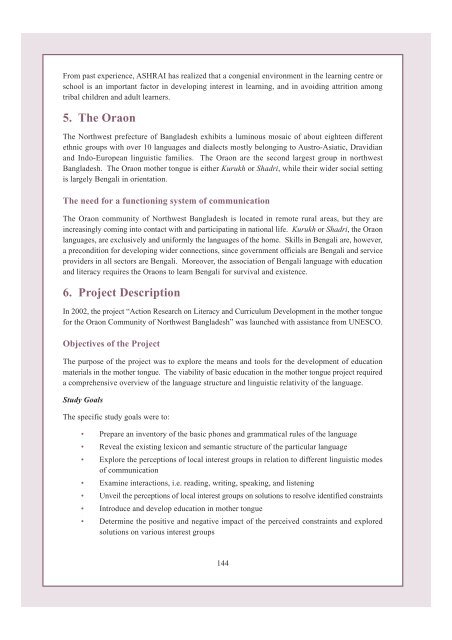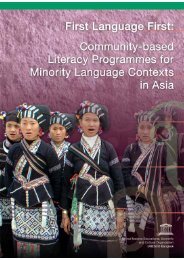Part II.pdf - MTB-MLE Network
Part II.pdf - MTB-MLE Network
Part II.pdf - MTB-MLE Network
You also want an ePaper? Increase the reach of your titles
YUMPU automatically turns print PDFs into web optimized ePapers that Google loves.
From past experience, ASHRAI has realized that a congenial environment in the learning centre or<br />
school is an important factor in developing interest in learning, and in avoiding attrition among<br />
tribal children and adult learners.<br />
5. The Oraon<br />
The Northwest prefecture of Bangladesh exhibits a luminous mosaic of about eighteen different<br />
ethnic groups with over 10 languages and dialects mostly belonging to Austro-Asiatic, Dravidian<br />
and Indo-European linguistic families. The Oraon are the second largest group in northwest<br />
Bangladesh. The Oraon mother tongue is either Kurukh or Shadri, while their wider social setting<br />
is largely Bengali in orientation.<br />
The need for a functioning system of communication<br />
The Oraon community of Northwest Bangladesh is located in remote rural areas, but they are<br />
increasingly coming into contact with and participating in national life. Kurukh or Shadri, the Oraon<br />
languages, are exclusively and uniformly the languages of the home. Skills in Bengali are, however,<br />
a precondition for developing wider connections, since government officials are Bengali and service<br />
providers in all sectors are Bengali. Moreover, the association of Bengali language with education<br />
and literacy requires the Oraons to learn Bengali for survival and existence.<br />
6. Project Description<br />
In 2002, the project “Action Research on Literacy and Curriculum Development in the mother tongue<br />
for the Oraon Community of Northwest Bangladesh” was launched with assistance from UNESCO.<br />
Objectives of the Project<br />
The purpose of the project was to explore the means and tools for the development of education<br />
materials in the mother tongue. The viability of basic education in the mother tongue project required<br />
a comprehensive overview of the language structure and linguistic relativity of the language.<br />
Study Goals<br />
The specific study goals were to:<br />
• Prepare an inventory of the basic phones and grammatical rules of the language<br />
• Reveal the existing lexicon and semantic structure of the particular language<br />
• Explore the perceptions of local interest groups in relation to different linguistic modes<br />
of communication<br />
• Examine interactions, i.e. reading, writing, speaking, and listening<br />
• Unveil the perceptions of local interest groups on solutions to resolve identified constraints<br />
• Introduce and develop education in mother tongue<br />
• Determine the positive and negative impact of the perceived constraints and explored<br />
solutions on various interest groups<br />
144
















